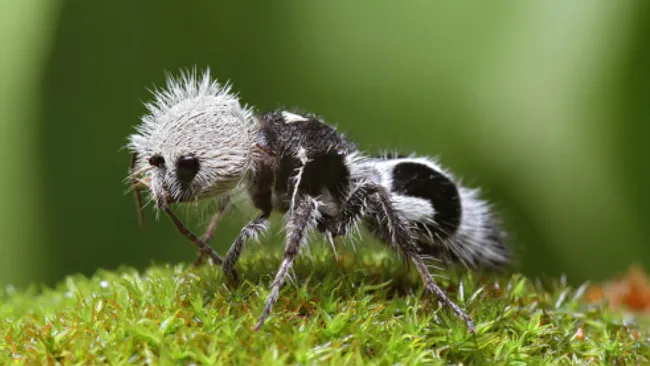Panda ants, scientifically known as Euspinolia militaris, are fascinating creatures found in the hot, dry coastal areas of Chile. Despite their misleading name, they are not ants but rather wingless female wasps that have evolved to mimic the appearance of large, hairy ants. Their striking velvety white coat adorned with black spots around the eyes and body gives them an uncanny resemblance to pandas (Ailuropoda melanoleuca), hence their common name.
Unlike their harmless appearance suggests, panda ants possess a potent venomous sting delivered by their stingers, which are modified egg-laying organs. These stingers can inflict intense pain on predators and prey alike, although they are not lethal to humans. The stingers are remarkably long, about half the length of their bodies, making them a formidable defense mechanism.
Panda ants lead solitary lives and do not form colonies like many other social insects. They forage independently for food, which includes feeding on flower nectar and hunting small insects. They are well adapted to sandy environments where they can easily locate food and find suitable nests of other insects, such as ground bees or wasps, in which to lay their eggs. After mating in flight, the females select a nest site, where they lay up to 2,000 eggs over their two-year lifespan. The larvae hatch and develop inside the host nest, consuming the host’s larvae before pupating and emerging as fully grown panda ants.
Beyond their deceptive appearance and potent sting, panda ants possess another intriguing ability—they can produce high-pitched sounds. These sounds, which can reach ultrasonic levels, serve multiple purposes. They may act as a mating signal during airborne courtship, helping to attract potential mates. Additionally, these sounds can deter predators, including rodents, potentially signaling danger or signaling their unpalatability.
In summary, panda ants are not only remarkable for their mimicry of ants and their painful sting but also for their solitary lifestyle, unique nesting behavior, and intriguing acoustic capabilities. Their adaptation to survive in harsh, arid environments and their complex reproductive strategies make them a fascinating subject for scientific study and admiration in the natural world.
